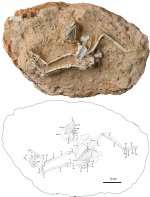Fred Ruhe
Well-known member

Zhiheng Li, Thomas A. Stidham, Xiaoting Zheng, Yan Wang, Tao Zhao, Tao Deng & Zhonghe Zhou, 2022
Early evolution of diurnal habits in owls (Aves, Strigiformes) documented by a new and exquisitely preserved Miocene owl fossil from China
Proceedings of the National Academy of Sciences of the United States of America. 119 (15): e2119217119. doi:10.1073/pnas.2119217119
Significance
Owls, with their largely nocturnal habits, contrast strikingly with the vast majority of diurnal birds. A new spectacular late Miocene owl skeleton from China unexpectedly preserves the oldest evidence for daytime behavior in owls. The extinct owl is a member of the clade Surniini, which contains most living diurnal owl species. Analysis of the preserved eye bones documents them as consistent with diurnal birds, and phylogenetically constrained character mapping coincides with a reconstruction of an early evolutionary reversal away from nocturnal habits in this owl group. These results support a potential Miocene origin of nonnocturnal habits in a globally distributed owl group, which may be linked to steppe habitat expansion and climatic cooling in the late Miocene.
Abstract: https://www.pnas.org/doi/abs/10.1073/pnas.2119217119
Nocturnal owls exhibit adaptations thought to be evolutionarily associated with their diets, morphologies (sensory and flight), and diel activity patterns. However, that evolutionary history is not so simple, as demonstrated by an exquisitely preserved partial skeleton of an owl from the late Miocene of China that represents the first fossil evidence for diurnal behavior among owls. The fossil from the high-elevation Liushu Formation preserves most of the skeleton including the scleral ossicles. Osteological features place the holotype specimen as a member of the strigid clade Surniini. In contrast to the largely nocturnal owls, nonnocturnal (diurnal and crepuscular) species are concentrated within the Surniini as a likely evolutionary reversal in diel activity patterns. Analyses of the preserved scleral ossicles in the fossil demonstrate that it exhibits a large exterior scleral ossicle ring diameter with a large orbital length, supporting the hypothesis that this extinct owl was largely diurnal in its habits. Furthermore, stochastic character mapping, combined with Bayesian ancestral state reconstruction of the activity patterns of extant birds, demonstrates higher posterior probabilities of diurnal behavior among early diverging Surniini, and the addition of this extinct taxon into analyses enhances the hypothesis of this clade’s diurnal origin. The fossil and associated analyses of the eye and behavioral evolution point to a long evolutionary history of nonnocturnal behavior among owls that has yet to be studied in detail. This diurnal owl joins a growing Liushu avifauna that would have hunted small mammals in the savanna-like habitats adjacent to the rising Tibetan Plateau.
Miosurnia diurna gen. nov. sp. nov. is described
Enjoy,
Fred
Early evolution of diurnal habits in owls (Aves, Strigiformes) documented by a new and exquisitely preserved Miocene owl fossil from China
Proceedings of the National Academy of Sciences of the United States of America. 119 (15): e2119217119. doi:10.1073/pnas.2119217119
Significance
Owls, with their largely nocturnal habits, contrast strikingly with the vast majority of diurnal birds. A new spectacular late Miocene owl skeleton from China unexpectedly preserves the oldest evidence for daytime behavior in owls. The extinct owl is a member of the clade Surniini, which contains most living diurnal owl species. Analysis of the preserved eye bones documents them as consistent with diurnal birds, and phylogenetically constrained character mapping coincides with a reconstruction of an early evolutionary reversal away from nocturnal habits in this owl group. These results support a potential Miocene origin of nonnocturnal habits in a globally distributed owl group, which may be linked to steppe habitat expansion and climatic cooling in the late Miocene.
Abstract: https://www.pnas.org/doi/abs/10.1073/pnas.2119217119
Nocturnal owls exhibit adaptations thought to be evolutionarily associated with their diets, morphologies (sensory and flight), and diel activity patterns. However, that evolutionary history is not so simple, as demonstrated by an exquisitely preserved partial skeleton of an owl from the late Miocene of China that represents the first fossil evidence for diurnal behavior among owls. The fossil from the high-elevation Liushu Formation preserves most of the skeleton including the scleral ossicles. Osteological features place the holotype specimen as a member of the strigid clade Surniini. In contrast to the largely nocturnal owls, nonnocturnal (diurnal and crepuscular) species are concentrated within the Surniini as a likely evolutionary reversal in diel activity patterns. Analyses of the preserved scleral ossicles in the fossil demonstrate that it exhibits a large exterior scleral ossicle ring diameter with a large orbital length, supporting the hypothesis that this extinct owl was largely diurnal in its habits. Furthermore, stochastic character mapping, combined with Bayesian ancestral state reconstruction of the activity patterns of extant birds, demonstrates higher posterior probabilities of diurnal behavior among early diverging Surniini, and the addition of this extinct taxon into analyses enhances the hypothesis of this clade’s diurnal origin. The fossil and associated analyses of the eye and behavioral evolution point to a long evolutionary history of nonnocturnal behavior among owls that has yet to be studied in detail. This diurnal owl joins a growing Liushu avifauna that would have hunted small mammals in the savanna-like habitats adjacent to the rising Tibetan Plateau.
Miosurnia diurna gen. nov. sp. nov. is described
Enjoy,
Fred




